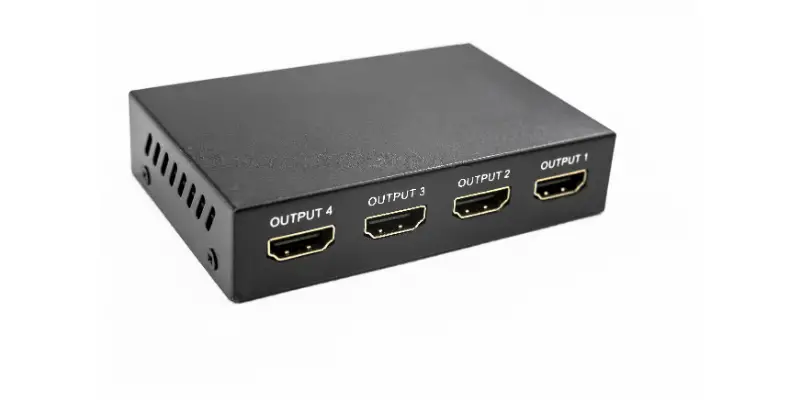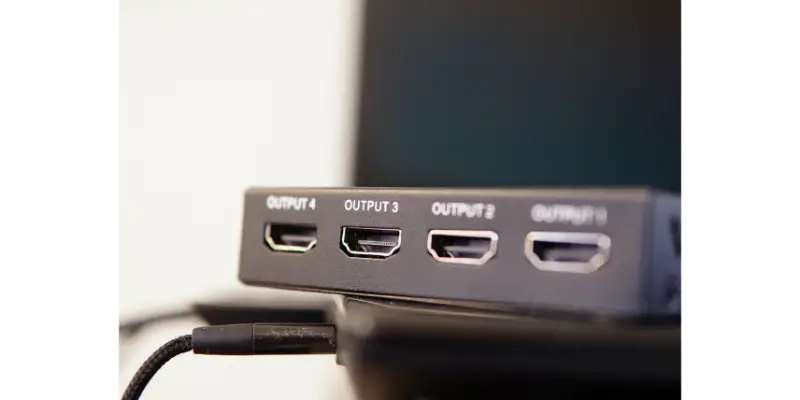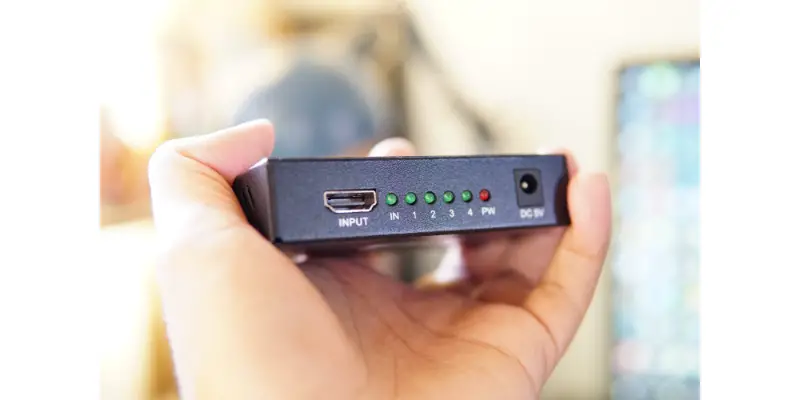Disclaimer: This post may contain affiliate links, meaning we get a small commission if you make a purchase through our links, at no cost to you. For more information, please visit our Disclaimer Page.
Computer users sometimes need multiple monitors to make their work very easy. While users can easily extend display, the number of the video-out port on their computer can limit the number of external monitors they can connect to their computer unless they use an HDMI splitter. We know that you might be wondering whether it’s really possible to extend the display with an HDMI splitter.
You can use an HDMI splitter to extend the display to several monitors at a time, but each of the monitors connected to the HDMI splitter will share the same signal.
It’s important to note that the monitors connected to the HDMI splitter will extend the display of the main screen only if the HDMI splitter and the main screen are not connected to the same video-out port. Kindly read on to get full information on extended display and to see how you can extend display using an HDMI splitter.
Table of Contents
Can You Use a Splitter for Dual Monitors?
In case you own a computer with only one video-out port, you might want to know whether you can use dual monitors when you purchase a splitter. Yes, you can. However, your computer’s graphics card must support up to two monitors simultaneously or you can insert an additional graphic card to use two monitors at a time.
Kindly note that the two monitors will display exact signals when you use a splitter, so if this isn’t what you want, then you should find another means to connect dual monitors to your computer instead of using a splitter.
In case you want the monitors to display different signals, then you should read further to see the various ways to extend the display.
Before we list out the various ways of extending display, let’s be sure you understand what extension is all about. When you extend your computer’s display, your computer will send different signals to the monitors connected to it.
Hence, you will be able to view different desktops on the connected monitors. Now that you fully understand what it means to extend a display, let’s show you the various ways you can extend the display.
Display extension using video-out port
Almost all computers have video-out ports that users can connect an additional monitor to. If your computer is a modern one, then it’s certain that it has at least one of the following video-out port:
- HDMI: This port supports the transmission of high-quality and audio between a computer and monitor. A few other devices like a DVD player and Blu-ray player also have an HDMI port for transmitting signals to monitors or HDTV. HDMI supports 4k display.
- VGA: This port used to be on almost all computers but HDMI now replaces VGA on most newer computers. In case you own a computer with a VGA port, then you can use it to extend the display. Kindly note that VGA doesn’t support 4k display.
- DVI: You can extend display via DVI port also, but it doesn’t support 4K displays.
- DisplayPort: Displays can be extended via DisplayPort. Just like HDMI, DisplayPort supports the transmission of high-quality video. DisplayPort 2.0, in particular, supports up to 16K display.
Display extension using a USB display adapter
In case your computer has USB Type-C but lacks all the other ports that we mentioned earlier, then you need a USB display adapter to extend the display to monitors. If you are lucky enough to get a monitor that supports USB Type-C directly, then you don’t necessarily need to buy an adapter, though it’s very rare to come across such monitors.
The input port on your monitor will determine the right type of USB display adapter to use. Generally, USB Type-C can extend the display to other monitors while maintaining a 4K display quality.
How to Extend the Display with One HDMI Port?
Just like we mentioned earlier, an HDMI port can be used to extend the display to an external monitor. However, you should note that the number of monitors you can extend the display to is limited to the number of HDMI ports on your computer. Let’s show you how you can extend display if your computer has only one HDMI port.
Start by connecting one end of an HDMI cable to the HDMI port on your computer and connect the other end of the same cable to the external monitor you intend to use. After you have done that, you should enable an extended display on your computer. Kindly follow the steps below to enable extension mode.
If you are using Windows 7, 8, or 10, press the “Windows key” and “P” simultaneously. A mini window will pop up when you press these two keys. Choose “extend” from the options you see to enable extended display.
In case you are using a Mac computer, follow the steps below to enable extended display. Your computer should automatically detect the external monitor once you turn it on.
However, if your computer couldn’t detect anything, you should go to the Apple menu –> System Preferences –> select Displays, then select Arrangement. Some instructions will display on your screen. Kindly follow those instructions to activate the extended display.
Can You Extend the Display with HDMI Splitter?
There are times when you will need to monitor two or more tasks on different screens. At such times, the best thing to do is to extend your computer’s display to a second screen.
If two screens are all you need, then you are very likely to set up the two screens without using an HDMI splitter. However, if you need more than two monitors, you will likely need an HDMI splitter.
HDMI Splitter can help you extend the display to multiple external monitors simultaneously. However, you should note that each of those external monitors will display the same extended display.
The best way to visualize the concept is as follows. The HDMI splitter receives an extended display from your computer and further shares the same signal to every external monitor connected to it.
We recommend using monitors with equal resolutions whenever you use an HDMI splitter. You may be wondering why it’s necessary to use monitors with equal resolutions but here is why.
HDMI splitter can’t vary the video resolution it sends to each of the monitors connected to it, so it will be forced to use a resolution that the least monitor can display.
For instance, if you connect a 1080p monitor and 4k monitor to an HDMI splitter, both monitors will receive 1080p video quality.
If you notice that the display on the external monitors is blurry or stretched, then you have to adjust the resolution. Kindly follow these steps to adjust the resolution.
If you are using a Windows computer, move the cursor to a blank space on the computer’s home screen and right-click on the mouse. Next, choose “Display settings” from the options that pop up. From here, click on “advanced settings”. Your computer will prompt you to choose a display.
Choose the appropriate display and open the resolution dropdown. Either increase or decrease the resolution until the display on the external monitors appears normally. Save the changes and test the new resolution with various images and texts.
If you are using a Mac computer, go to the Apple menu –> System Preferences –> then choose Displays. Press the “Option key” and hold it in place while you click Scaled.
You will see all the available resolutions for the external monitors when you do this. Choose these resolutions one after another until the external monitors display normally.
How to Extend Display with HDMI Splitter?
If you own a laptop or any computer with a built-in display, you can decide to extend your computer’s display to external monitors if you have at least an additional HDMI port on your computer.
It usually takes just a few minutes to add additional monitors to computers. Here are the things you need to do in order to extend the display with an HDMI splitter:
Set up the connection
The first thing you need to do while your computer and external monitor are turned off is to set up the connection. Start by plugging the HDMI splitter into the HDMI port on your computer. After that, you should connect your external monitors to the HDMI ports on your HDMI splitters.
Enable extended display
After you have set up the connection, you should enable an extended display on your computer. Kindly switch your computer on and follow the steps below to enable extended mode.
If you are using a Windows computer with Windows 7, 8, or 10 software, press the “Windows key” and “P” simultaneously. Some options will pop up. Choose “extend” from those options to enable extended display. Your computer’s main screen and external screen may blink as soon as you enable the extended display mode.
The way to enable extended mode on a mac computer is a little bit different from that of a Windows computer.
In case you are using a Mac computer, follow these steps to enable extended display. Your computer should automatically detect the external monitor once you turn it on.
However, if your computer couldn’t detect anything, you should go to the Apple menu –> System Preferences –> select Displays, then select Arrangement. Some instructions will display on your screen. Kindly follow those instructions to activate the extended display.
Adjust resolution if necessary
If you notice that the display on the external monitors is blurry or stretched, then you have to adjust the resolution. Kindly follow these steps to adjust the resolution.
If you are using a Windows computer, move the cursor to a blank space on the computer’s home screen and right-click on the mouse. Next, choose “Display settings” from the options that pop up. From here, click on “advanced settings”. Your computer will prompt you to choose a display.
Choose the appropriate display and open the resolution dropdown. Either increase or reduce the resolution until the display on the external monitors appears normally. Save the changes and test the new resolution with various images and texts.
If you are using a Mac computer, go to the Apple menu –> System Preferences –> then choose Displays. Press the “Option key” and hold it in place while you click Scaled.
You will see all the available resolutions for the external monitors when you do this. Choose these resolutions one after another until the external monitors display normally.
Conclusion
Without any doubt, an HDMI splitter is a must-have for people whose computers don’t have enough video-out ports to extend the display to all the monitors they intend to use. You just have to make sure your computer’s video card support multiple displays. Also, ensure the HDMI splitter and the computer’s main screen aren’t connected to the same video-out port if you want to extend the display.



